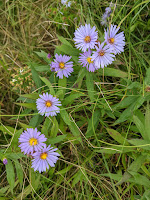Red Chokeberry and Viking Chokecherry
Last year I bought four chokeberry plants at the Fedco tree sale: two native Red Chokeberry (Aronia arbutifolia) and two european ones identified as Viking Chokecherry. I planted them inside my chicken pen so they might benefit from the shade, insect visitors and any falling fruits in the fall. Shown on the left here are the viking chokecherries that I understand may be used for culinary purposes. These plants were larger from the start but they have adapted very well to their new home.
Only one of the two plants actually flowered and I am not sure why that is the case. However, notice how beautiful the leaves are.... they are almost completely untouched by insects. Fortunately, however, the flowers are gorgeous and are already providing some benefit, at least for this one visitor on the left side of this photo! I don't have any idea what it might be. If you have any possible leads please post them in the comments.
You can see in this photograph that the Red Chokeberries in front are much smaller than the viking chokecherries in the back. According to the Fedco information when I purchased the plants, the red chokeberries will grow taller, up to 12 feet high, so I planted them a little further down the slope to give them more room before they hit the rafters of my chicken pen. These plants were much much smaller and less branched when I purchased them, so it is not an apples to apples comparison.
Unlike the european viking chokecherry which has perfect leaves and flowers, the native Aronia arbutifolia (red chokeberry) shows very dramatic signs of being foraged by caterpillars as you can see in the photograph on the right. Fortunately, I chose these shrubs in order to attract butterflies and insects and I am excited that is exactly what they are doing. In this picture here you can see one of the culprit caterpillars with a dark green stripe and several white ones that has been chomping into the leaves and is in the process of building a nest. I have asked for help identifying the species on the Native Plants of New England facebook group (as well as moths of massachusetts) and will follow up here if I can identify the species.
Gardening with native perennials is a slow process and I have to accept that it is something I do for others who decide if, when and how to make use of the habitat that I try to provide for them. Small victories like these though are the reasons for doing this. You can plant all the flashy alien species with their exotic foliage and flowers that may provide some with instant gratification. To me it is like looking at advertising. It may look cool but it only fools you into accepting a life of consumerism without substance that endures into the future. We take a hard road when we live or our lives for the next generation, but the reward is greater than any flower that lasts only a season. Whether you grow perennials for fruit, for insects, or even just to make the world a more attractive place, it is always about the future isn't it?
NOTE ABOUT SEEING IMAGES: If you click on the images they will open in a new window. Then right click on the image and select "copy image address". You can then paste that address into a new browser window which will allow you to zoom in and see the details. Sorry it takes an extra step to do that.
 |
| click to see the cool bug! |
You can see in this photograph that the Red Chokeberries in front are much smaller than the viking chokecherries in the back. According to the Fedco information when I purchased the plants, the red chokeberries will grow taller, up to 12 feet high, so I planted them a little further down the slope to give them more room before they hit the rafters of my chicken pen. These plants were much much smaller and less branched when I purchased them, so it is not an apples to apples comparison.
 |
| click to see the caterpillar |
Gardening with native perennials is a slow process and I have to accept that it is something I do for others who decide if, when and how to make use of the habitat that I try to provide for them. Small victories like these though are the reasons for doing this. You can plant all the flashy alien species with their exotic foliage and flowers that may provide some with instant gratification. To me it is like looking at advertising. It may look cool but it only fools you into accepting a life of consumerism without substance that endures into the future. We take a hard road when we live or our lives for the next generation, but the reward is greater than any flower that lasts only a season. Whether you grow perennials for fruit, for insects, or even just to make the world a more attractive place, it is always about the future isn't it?
NOTE ABOUT SEEING IMAGES: If you click on the images they will open in a new window. Then right click on the image and select "copy image address". You can then paste that address into a new browser window which will allow you to zoom in and see the details. Sorry it takes an extra step to do that.






Hi Justin-I think 'Viking' is a cultivar of Aronia melanocarpa, which is a native shrub. Ellen
ReplyDeleteThis comment has been removed by a blog administrator.
ReplyDelete